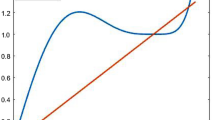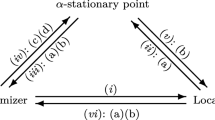Abstract
In this work, we use a new approach that relies on the theory of matrix iterative analysis to study the convergence behavior of the linear group-wise successive interference cancellation (GSIC) detector. Particularly, we show that the linear GSIC detector is in fact a realization of a modified block successive over-relaxation (BSOR) iterative method where the relaxation factor is a matrix instead of scalar. Consequently, to study the convergence behavior of the GSIC detector, we propose two new corollaries that extend the famous work of Kahan (Varga, Matrix iterative analysis, 2000) to the case where the relaxation factor is a matrix instead of a scalar. Using the two new corollaries we develop two new conditions of convergence for the linear GSIC detector. Simulation results are in excellent agreement with theory.
Similar content being viewed by others
References
Buehrer R.M., Correal-Mendoza N.S., Woerner B.D. (2000) A simulation comparison of multi-user receivers for cellular CDMA. IEEE Transactions on Vehicular Technology 49(4): 1065–1085
Jamal, K., & Dahlman, E. (1996). Multi-stage serial interference cancellation for DS-CDMA. In Proceedings of IEEE 46th VTC Conference (Vol. 2, pp. 671–675), 28 April–1 May 1996.
Rasmussen L.K., Lim T.J., Johansson A. (2000) A matrix-algebraic approach to successive interference cancellation in CDMA. IEEE Transactions on Communications 48(1): 145–151
Guo D., Rasmussen L.K., Sun S., Lim T.J. (2000) A matrix-algebraic approach to linear parallel interference cancellation in CDMA. IEEE Transactions on Communications 48(1): 152–161
Verdu, S. (1998). Multi-user detection. Cambridge University Press.
Rasmussen, L. K., Lim, T. J., & Johansson, A. L. (1997). One-shot filtering equivalence for linear successive interference cancellation in CDMA. In Proceedings of IEEE 47th VTC Conference (Vol. 3, pp. 2163–2167), 4–7 May 1997.
Rasmussen, L. K., Lim, T. J., & Johansson, A.-L. (1997). Convergence of linear successive interference cancellation in CDMA. In Proceedings of 3rd MMT Workshop (pp. 13–27), Melbourne, Australia, Dec. 1997.
Juntti M.J., Aazhang B., Lilleberg J.O. (1998) Iterative implementation of linear multiuser detection for dynamic asynchronous CDMA systems. IEEE Transactions on Communications 46(4): 503–508
Tan P.H., Rasmussen L.K. (2000) Linear interference cancellation in CDMA based on iterative techniques for linear equation systems. IEEE Transactions on Communications 48(12): 2099–2108
Johansson, A. L., & Rasmussen, L. K. (1998). Linear group-wise successive interference cancellation in CDMA. In Proceedings of IEEE 5th ISSSTA 1998 (Vol. 1, pp. 121–126), 2–4 Sep. 1998.
Sun, S., Rasmussen, L. K., Sugimoto, H., & Lim, T. J. (1998). A hybrid interference canceller in CDMA. In Proceedings of IEEE 5th ISSSTA 1998 (Vol. 1, pp. 150–154), 2–4 Sep. 1998.
Sun, S., Rasmussen, L. K., Lim, T. J., & Sugimoto, H. (1998). A matrix-algebraic approach to linear hybrid interference cancellation in CDMA. In Proceedings of ICUPC’98 (Vol. 2, pp. 1319–1323), 5–9 Oct. 1998.
Bentrcia A., Sheikh A.U., Zerguine A. (2006) A new ordering and grouping algorithm for the linear weighted group matched filter successive interference cancellation detector. IEEE Transactions on Vehicular Technology 55(2): 704–709
Varga, R. S. (2000). Matrix iterative analysis (2nd ed.).
Bentrcia, A., Zerguine, A., & Sheikh, A. U. (2004). The effect of Users’ Grouping on the Convergence Behavior of the Linear Group-Wise SIC. In Proceedings of IEEE TENCON04 (pp. 501–504), Nov. 2004.
Junti, M. (1998). Multiuser demodulation for DS-CDMA systems in fading channels, PhD thesis, Oulu University, Department of Electrical Engineering, Oulu, Finland, 1998.
Author information
Authors and Affiliations
Corresponding author
Rights and permissions
About this article
Cite this article
Bentrcia, A., Zerguine, A. Analysis of the Linear GSIC Multiuser Detector Using a Matrix Iterative Approach. Wireless Pers Commun 49, 1–13 (2009). https://doi.org/10.1007/s11277-008-9551-9
Received:
Accepted:
Published:
Issue Date:
DOI: https://doi.org/10.1007/s11277-008-9551-9




